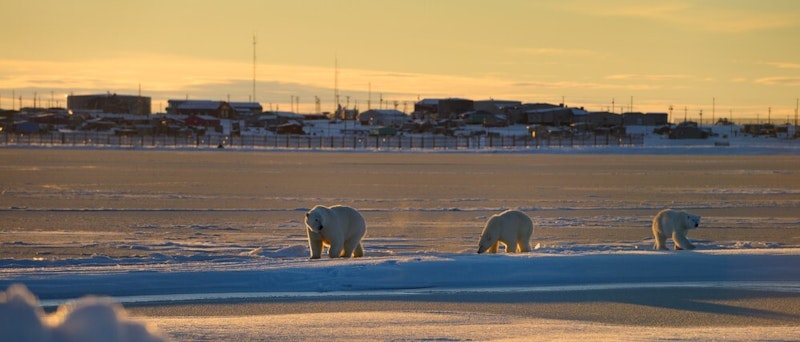Study Notes
GCSE Geography | Adapting to Cold Environments (Cold Environments 2)
- Level:
- GCSE
- Board:
- AQA, Edexcel, OCR, Eduqas
Last updated 19 Jul 2023
Cold environments like the polar and tundra biomes have lower levels of biodiversity than most other global biomes, this is due to the lack of precipitation (which tends to fall as snow) and the extreme cold, which makes nutrient cycling difficult. Plants and animals have to make adaptations to be able to survive in such harsh conditions.
How do plants adapt to the conditions in cold environments?
Very few plants are found in polar regions, however a wide variety of plant species are able to thrive in the tundra biome, as they have evolved specific adaptations that help them cope with the harsh environment - low temperatures, strong winds and a lack of precipitation.
Permafrost - this means that the ground is permanently frozen, which is the case all year round in the polar biome, although the top layer of soil will thaw in the summer in the tundra biome, leaving a frozen layer below. The frozen ground means that plants can't establish long roots, so only species with shallow root systems will survive, such as mosses, lichens and some low-growing shrubs. The word 'tundra' actually means 'treeless' in Finnish - and trees cannot survive in these conditions as they need to establish deep roots for stability, which they can't do because of the frozen ground.
Waterlogging and poor drainage - in the summer the top layer of soil which was frozen over winter melts, however because the lower levels of soil are still frozen, a barrier of ice prevents water from infiltrating downwards into the soil, causing widespread waterlogging. Here plants have to be able to tolerate the very dry conditions of the winter, and the very wet conditions of the summer, so have to be very hardy like mosses
Low insolation - polar and tundra regions have high latitudes meaning that solar energy hits the surface at an angle and the sun's rays are spread out, making light weak even during the summer when it is daylight most of the time. During the winter daylight only happens for a few hours and snow covers plants entirely for much of the year. This has meant that plants have had to adapt to find ways to maximise the potential for photosynthesis during the very short growing season. Most plants are perennials (they do not have a woody structure) that bloom in the summer and die back in the winter. They can start the process of photosynthesis as soon as there is sunlight as they don't have to wait to regrow their leaves, and they often start producing flowers very quickly while the snow is still melting. Rapid flowering and seed formation means that reproduction can take place during the short summer season.
Strong winds - Polar and tundra regions are blasted by strong icy winds from the North Pole, so plants need to adapt to keep warm and minimise water loss through transpiration. Plants grow low and close together to protect themselves from the wind by trapping pockets of air. They usually have hairy stems and tiny hairs on their leaves to trap heat, and their leaves are thin and waxy to reduce water loss through transpiration.
An example of a plant that thrives in cold environments is the bearberry plant. It is less that 15cm off the ground, with a thick stem to protect from strong winds. It has a hairy stem to keep warm, and small bright green leathery leaves to maximise photosynthesis and retain moisture. It also has bright red berries which attracts birds who help with seed dispersal.

How do animals adapt to the conditions in cold environments?
Biodiversity is relatively low in cold biomes however some animal species have adapted well.
In the Arctic Polar bears are probably the most well-known – they retain heat with their thick fur and an insulating layer of fat, as well as having a black nose and black foot pads to absorb heat from the sun. They spend most of their time hunting seals in the northern part of the Arctic Ocean, and when seals are scarce they roam inland to the Tundra, often ending up in towns where they can cause problems. Polar bears hibernate during winter as it is so cold and there is little food available, using the thick layer of fat they have built up at other times of the year to keep them well-insulated.
In Antarctica penguins adopt a variety of adaptations to help them survive. They have thicker plumage than any other bird, with two layers of feathers, long stiff feathers on the outside and softer on the inside. This double layer traps body heat so provides good insulation. Their feathers are also water-resistant which keeps them warm even when they are swimming in the freezing Antarctic Ocean, and buoyant so penguins can float when needed. Penguins have streamlined bodies which helps to reduce drag when swimming so they can move quickly through the water whilst conserving their energy. They also have tiny flippers and webbed feet which help them propel under water to get food and avoid predators. In addition penguins have a thick layer of blubber to keep them warm and provide them with energy when food is scarce, and finally, they huddle in large groups to keep warm - penguins are very organised here and rotate from the edge to the centre to ensure that everyone stays warm and is able to rest for a bit.
In the tundra many animals such as the Arctic fox and snow shoe hare have white fur, meaning they are camouflaged against the white snow – good for being a predator, and for keeping out of sight is you are being hunted. Caribou and musk ox keep warm when it is freezing cold by having two layers of thick fur - fur keeps them warm anyway but they are also able to trap air between the layers, giving them better insulation from the bitter temperatures. Caribou and musk ox also have very large hooves - these enable them to travel over waterlogged land and protect their feet from rotting, and they can also use them to break through thick ice in order to find drinking water. Many species in the tundra also hibernate during the winter, whereas others might migrate to warmer regions, such as birds flying south.

You might also like

Alaska's Permafrost is Thawing
24th August 2017

Are protected cold environments really that safe? It seems not!
16th March 2023
Cold Environments | AQA GCSE Geography
Quizzes & Activities